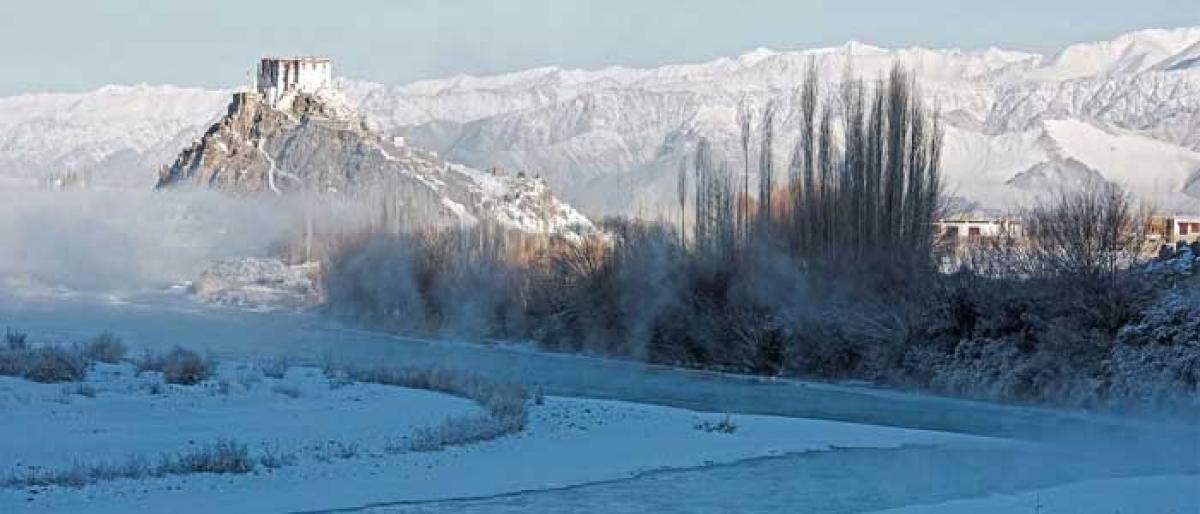A winter in Ladakh

If you love the mountains and rue the times when they were the place when one went to, to seek solace and find themselves, then here is why you should think Ladakh this winter. Seconds before landing at the Leh airport I felt my heart racing.
If you love the mountains and rue the times when they were the place when one went to, to seek solace and find themselves, then here is why you should think Ladakh this winter. Seconds before landing at the Leh airport I felt my heart racing. We had finally made it. After uncertain days of cancelled flights and hopeful nights in the transit hotels of Delhi, I was finally here. In the lap of the Himalayas, witnessing for the first time in my life the absolute whiteness of snow all around me.
Drive through constantly changing landscapes
The first thing one notices in Ladakh in winter is that here the landscape changes every day, every hour and just driving through this pristine and untouched white Ladakh is in itself a beautiful journey. Right from the glittering ice on the frozen Indus River by the road as the sun comes up to how the sun-kissed peaks in the clear distance light up at sunset, there is so much beauty. One can drive short distances from Leh to the monasteries close by like the Shey Palace, Spituk, Thiksey and the Tiger’s Nest. Or go the distance by driving to the hot springs in Chumathang or even further to Ladakh’s most famous lakes the Pangong Tso and Tso Moriri.
Explore popular tourist spots
Prayer flags flutter in the cool crisp breeze against the stark backdrop of the snow-covered mountains touching the flat white sky and there isn’t a soul in sight. This, however, isn’t just a one-off experience when you make that random stop along your road trip. Be it the popular Shanti Stupa, the monasteries in and around Leh or the roads that whisk you off further into the heart of this exotic land, you will find them all relatively deserted, save a few locals.
Experience sub-zero temperatures
Bundled up in layers and insulated pants, I experienced temperatures of the kind I had only dreamt of till then. It took five men just to get us out of knee-deep snow and back on our way on the road to Tso Moriri, as our massive SUVs struggled to trudge through the snow. Every experience like this in the stillness of the mountains as you watch the flurries of snow swirling down to your feet is a memory to be savoured for a lifetime.
Meet the Nomads
In Changthang valley in the Eastern Ladakh Region is Puga, a small nomadic village where the Tibetan Nomads on the Indian side settle down for the four cold winter months and tend to their animals. Spread across a stretch of 12 kilometres in the Changthang Wildlife Sanctuary, this valley is one of the important geothermal sites in the country. In this harsh and unpredictable land interspersed with geysers and hot springs, the Changpas, traversing the same migratory routes across Ladakh, bring their livestock to the same seasonal pastures every year.
They come from the village of Hanle, their summer home and stay in their semi-permanent encampments in Puga. The Changpas are a warm and friendly people and their children spending their school vacations here, will happily take you around, for the novelty of visitors in winter is a welcome distraction.
Witness changing seasons
If you have already been to Ladakh during the tourist season between May to September, this is a reason enough for you to revisit the land of high passes offseason. For, while the charm of Ladakh in summer lies in its vivid blue skies and stark landscapes, winter Ladakh’s lies in the powdered sugar patterns of snow on the same barren and rocky landscape. Only, minus the crowds.
Winter Ladakh’s biggest draw though, remains the Chadar Trek. As winter sets in and temperatures drop, the north-flowing tributary of the Indus River, the Zanskar freezes over. What in summer is a mighty, indomitable swirl is tamed by the ‘blanket of ice’, the chadar that forms on it.
This sheet of ice that is on an average six feet deep, is crossed by hundreds of trekkers every year to see the now celebrated frozen waterfall at Naerak. As the human pressure on this phenomenon of nature increases, the possibility of a trek on the Zanskar itself disappears.










